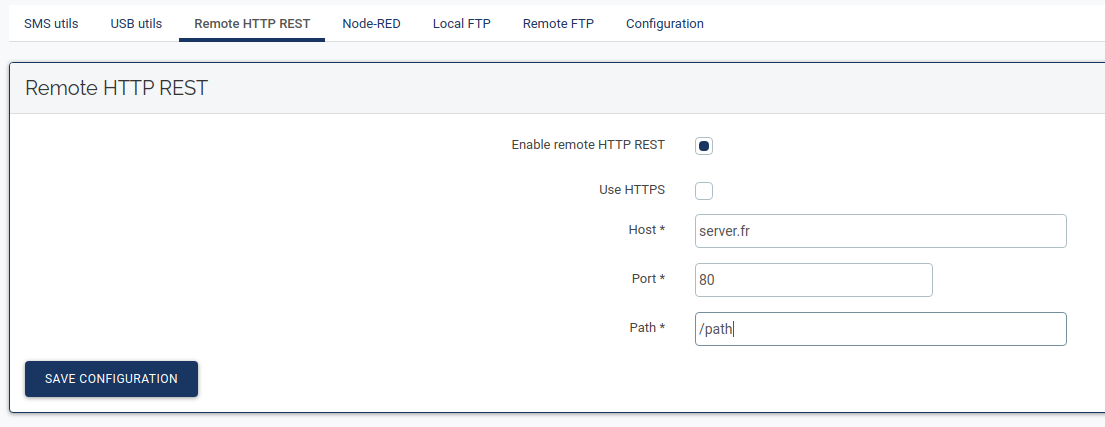Table of Contents
Remote HTTP
Introduction
A HTTP client is running on the gateway. It can be used to forward end-devices Rx data to HTTP server in real-time (Rx data are forwarded as soon as they are received).
Its configuration is available in Configuration ⇒ Interfaces ⇒ Remote HTTP menu.
It is possible to configure:
Host: IP address or hostnamePort: portPath: destination directory
rx_data suffix is no more added automatically in URL since SPN version 2.1. You must add it in path if used in your HTTP server configuration.
All data transmitted between client and server are encoded in JSON format.
If transmission fails, frames not sent are stored to be sent later on. The 10000 most recent frames are saved in RAM, the other ones are discarded. Frames are deleted from the RAM once successfully transmitted.
The examples featured in this guide use the program ncat to simulate an HTTP server.
For testing purposes, you could also use mockable.io.
Receive data
The gateway will send a POST requests when it receives frames from an end-device. The body of this request will contain the data of the received frames as a JSON string.
The HTTP headers indicate:
- The
Content-Typeis set toapplication/json, meaning that the body of the HTTPPOSTcontains a JSON string. - The
Acceptis also set toapplication/json, meaning that the server can reply with a JSON string.
The HTTP body contains an rx_data JSON object.
Rx packets structure
Here is the structure of an RX packet sent over HTTP:
rx_data_id: integer. RX data unique identifierend_device_id: string. The Device EUI or DevAddr depending on the activation procedurereceived_time: integer. Unix timestampsequence_number: integer. Sequence number sent by the end-deviceport: integer. LoRaWAN port to be usedradio_id: integer. Radio identifier (range [0;1])channel: integer. Channel identifier (range [0;9])rssi_dbm: integer. RSSI in dBmsnr_db: float. LoRa SNR ratio in dBfrequency_hz: integer. TX central frequency in Hzmodulation_type: string. Modulation type, eitherLoRaorFSKdata_rate: string. Data rate.
→ if the modulation isLoRa,datrisSFxBWywherexrepresents the spreading. factor (range 7-12 inclusive), andyis the bandwidth in kHz
→ if the modulation isFSK,datris the FSK bit rate in bpscoding_rate: string. ECC coding rate. Example:4/5adr: boolean. Adaptative Data rate enablepayload: string. Base64-encoded payload data
Example
Here is an example of one RX packet sent by the Wanesy SPN gateway.ncat, awk and jq are used to illustrate this example:
ncat -lp 12345 | awk '/^\r$/ { body=NR } body && NR > body { print $0 }' | jq -r .
- Launches
ncatto listen on the TCP port 12345. - The
awkscript discards the HTTP headers and prints the HTTP body. jqwill prettyprint the JSON string on the console.
Output:
$ ncat -lp 8000 | awk '/^\r$/ { body=NR } body && NR > body { print $0 }' | jq -r .
{
"rx_data": {
"rxdata_id": 77,
"end_device_id": "0018B20000000BAA",
"received_time": 1510669226,
"sequence_number": 1,
"port": 1,
"radio_id": 0,
"channel": 1,
"rssi_dbm": -45,
"snr_db": 9.2,
"frequency_hz": 868300000,
"modulation_type": "LORA",
"data_rate": "SF12BW125",
"coding_rate": "4/5",
"adr": 1,
"payload": "nhxICQcQABNRUSYAAA53"
}
}
Help
Inline help is available in web user interface in Configuration ⇒ Interfaces ⇒ Remote HTTP ⇒ Help
An extract of this help is available below:
Click to display ⇲
Click to hide ⇱
Common parameters
This service is used to push Rx data to a HTTP server via REST API.
The common URI is:
http(s)://path.to.host:port/path
- path.to.host: host name or IP address.
- port: server port.
- path: path, starts with /.
Flow syntax
Rx data flow
Rx data are pushed to:
http(s)://path.to.host:port/path
